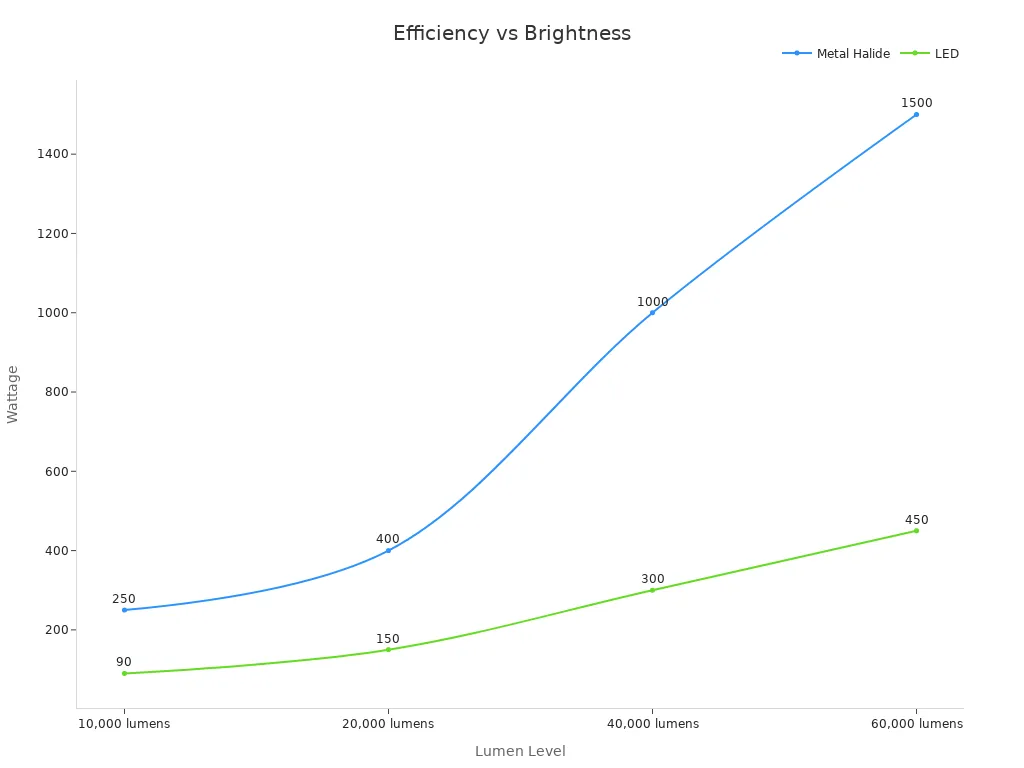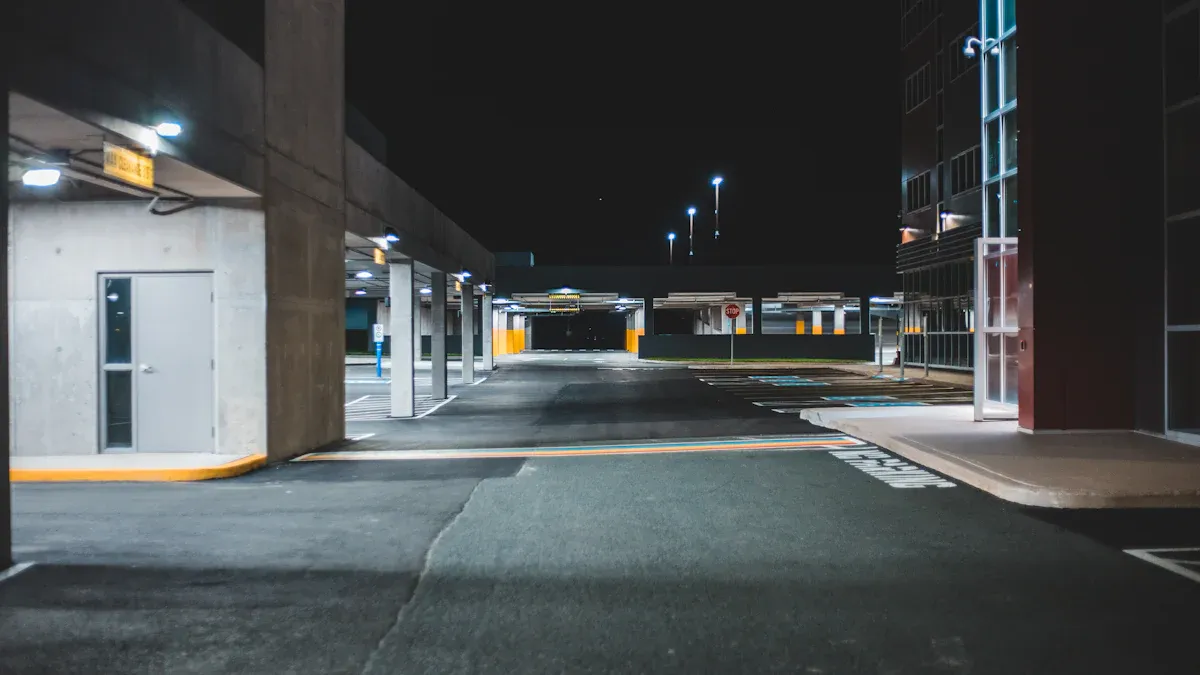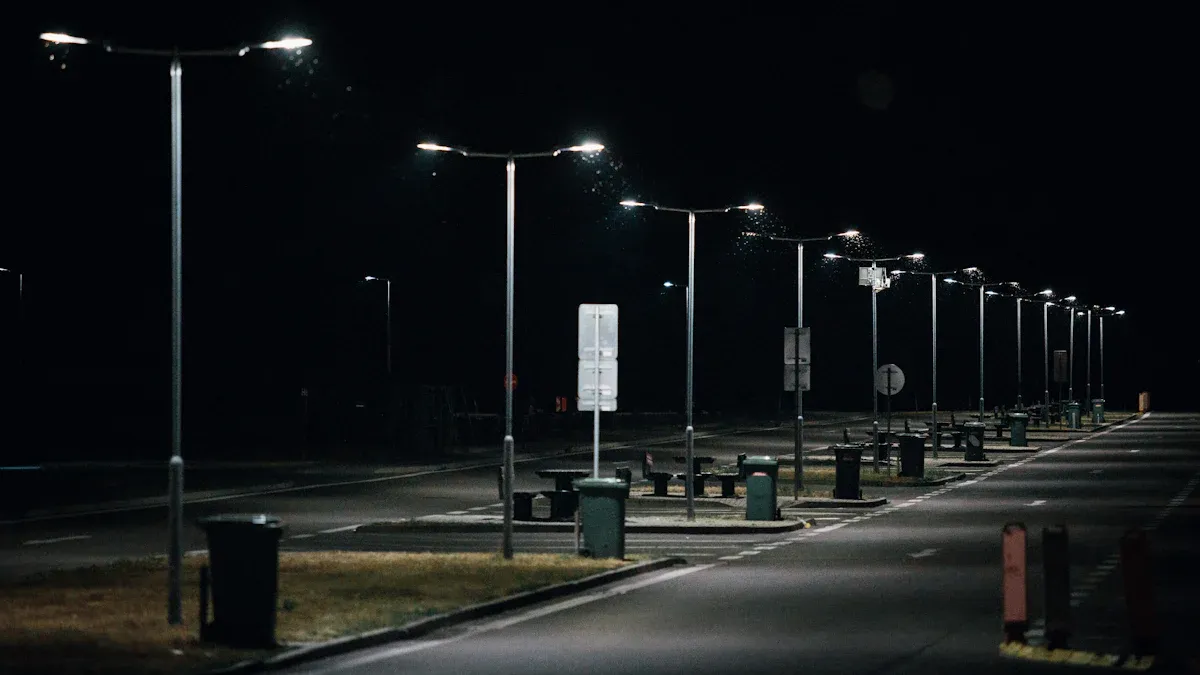Choosing the Right Parking Lot LED Light: Wattage, Brightness, and Mounting Options

Choosing the best parking lot LED light is important for safety. It also helps save energy and money. Good lighting can lower crime by 21%. This isn’t just a number—it makes parking lots safer. Many crimes, like theft or attacks, happen in parking lots. About 80% of shopping center crimes occur there. Bright lights can make these places safer for everyone. They also help drivers and walkers see better. Think about wattage, brightness, and how lights are mounted. These choices make parking lots safer and more useful.
Key Takeaways
Picking the right wattage and brightness makes parking lots safer. Match the wattage to your lot's size for better lighting.
LED lights use less energy, saving up to 70% power. They cost less on bills but still shine just as bright.
Even lighting is important for safety. Use a 3:1 brightness ratio to avoid dark areas and see clearly.
Choose mounting types based on your lot's design. Pole lights are good for big spaces, while wall lights fit smaller areas.
Make sure lights can handle bad weather. Look for LED lights with an IP65 rating or higher to last through tough conditions.
Why Wattage, Brightness, and Mounting Options Matter
How They Affect Lighting and Energy Use
Parking lot lights need the right wattage, brightness, and mounting. These factors decide how well the lights work. Energy-saving lights should still be bright enough for the whole area. LED lights use 70% less energy than older lights. For example, a 300-watt LED can replace a 1,000-watt bulb. This saves energy but keeps the same brightness.
The size of the parking lot also matters. Small lots may need 16,000 lumens, while big ones need up to 40,000 lumens. Here’s a simple chart:
Area Size (feet) | Needed Lumens |
|---|---|
15 to 20 | 16,000 to 20,000 |
20 to 30 | 40,000 |
Picking the right wattage and brightness avoids wasted energy. It also prevents dark spots in the lot. Directional lighting helps aim light where it’s needed. This improves safety and reduces shadows.
Making Parking Lots Safer and Easier to See
Good lighting isn’t just about saving power. It keeps people safe. Bright, even lighting helps drivers see walkers and other cars. It also helps people walk safely through the lot. Light uniformity means the light spreads evenly. A 3:1 ratio is best for parking lots. This avoids areas being too bright or too dark.
Bright lights also help stop crime. Studies show better lighting lowers crime rates. In New York, crime dropped by 39% in well-lit areas. Bright lights remove hiding spots and make people feel safer. This encourages more people to use the space and interact.
By choosing the right wattage, brightness, and mounting, you can make parking lots safe, energy-efficient, and welcoming for everyone.
Choosing the Right Wattage for Parking Lot LED Lights
Picking the right wattage for parking lot lights is important. Wattage shows how much energy a light uses. It also affects how bright and efficient the light is. Let’s go step by step to find the best wattage for your parking lot.
Deciding Wattage Based on Lot Size
The size of your parking lot helps decide the wattage needed. Bigger lots need more wattage for enough light. Smaller lots can use less wattage. Here’s a simple guide:
Small lots (under 10,000 sq. ft.): Use 40 to 100 watts. These lights are bright and save energy.
Medium lots (10,000 to 50,000 sq. ft.): Choose 100 to 200 watts. This range lights the area evenly.
Large lots (over 50,000 sq. ft.): Go for 200 to 400 watts or more for full coverage.
For example, a small store lot may need 16,000 lumens. A large business lot might need up to 50,000 lumens. Matching wattage to lot size gives the right brightness and saves energy.
Saving Energy While Staying Bright
You can save energy and still have bright lights. LEDs are very efficient compared to older lights. They give the same brightness but use less power. For instance, a 300-watt LED can replace a 1,000-watt metal halide light. This saves up to 70% energy.
Here’s a comparison of lumens and wattage for metal halide vs. LED lights:
Lumen Level | Metal Halide Wattage | LED Wattage |
|---|---|---|
60,000 lumens | 1,500 watts | 450 watts |
40,000 lumens | 1,000 watts | 300 watts |
20,000 lumens | 400 watts | 150 watts |
10,000 lumens | 250 watts | 90 watts |

Switching to LED lights saves money too. Each fixture can save up to $300 yearly on electricity. This is great for large lots with many lights.
Common Wattage Ranges for LED Parking Lot Lights
LED parking lot lights come in different wattages for various needs. Here’s a quick look:
Lighting Type | |
|---|---|
LED | 65 to 400 watts |
HID | 400 to 1,000 watts |
Smaller lots often use 40 to 60-watt lights. Larger lots may need up to 400 watts. Switching from HID to LED cuts energy use by 40% to 60%. This makes LEDs the best choice for saving energy.
When picking wattage, check the LED’s efficiency. Higher lumens per watt mean more brightness with less energy. For example:
Lumen Output | Wattage (110 Lumen/watt) | Wattage (130 Lumen/watt) | Wattage (160 Lumen/watt) |
|---|---|---|---|
10,000 | 90 Watts | 76 Watts | 62 Watts |
20,000 | 181 Watts | 153 Watts | 125 Watts |
50,000 | 454 Watts | 384 Watts | 312 Watts |
By following these tips, you can pick the best wattage for your parking lot. Whether it’s a small store lot or a big commercial space, the right wattage ensures safety, energy savings, and lower costs.
Understanding Brightness in LED Parking Lot Lights

Brightness is very important for parking lot safety. It helps create a welcoming and secure space. But what does brightness really mean? Let’s explain it simply.
What Are Lumens and Why Do They Matter?
"Lumens" tell you how bright a light is. Unlike wattage, which shows energy use, lumens focus on light output. LEDs are great because they give more light using less energy. For example, a 300-watt LED is as bright as a 1,000-watt old bulb. This makes lumens more important than wattage when picking LED lights.
Here’s a simple chart to compare LEDs and older lights:
Lumen Output | Traditional Wattage | LED Wattage |
|---|---|---|
10,000 | 250 watts | 90 watts |
20,000 | 400 watts | 150 watts |
50,000 | 1,000 watts | 300 watts |
LEDs save energy and money while giving enough light. They also aim light where it’s needed, reducing wasted brightness.
Tip: Always check the lumen rating when buying lights. Higher lumens mean brighter light, but match it to your lot’s size.
How to Spread Light Evenly
Have you seen parking lots with dark and bright spots? That happens when light isn’t spread evenly. Even lighting makes it easier to see and removes shadows where accidents or crimes could happen.
To spread light evenly, think about your lot’s layout and where lights go. LED lights can cut dark areas by 30%. The best lighting ratio is 3:1. This means the brightest spots shouldn’t be more than three times brighter than the darkest ones.
Here are some tips for even lighting:
Use pole lights that can be adjusted to cover more space.
Place lights evenly to avoid gaps or overlaps.
Pick LEDs with wide beam angles for better coverage.
Even lighting makes parking lots safer and more professional-looking.
Brightness for Safety
Safety is the most important reason for good lighting. Brighter parking lots are safer. Studies show LED lights can lower crime by 41%, compared to 19% with older lights. LEDs give steady, clear light that removes hiding spots and improves visibility.
For safety, choose lights with a color temperature of 5000K. This "daylight" color helps people see clearly. A high CRI (85 or more) makes security footage clearer and helps identify faces and objects. LEDs with special designs can also reduce dark areas and improve safety.
Did you know? Well-lit parking lots have 30% fewer dark spots, making them safer for everyone.
By understanding brightness, you can pick LED lights that make your parking lot safe and inviting for all.
Exploring Mounting Options for Parking Lot Lights

Picking the right way to mount lights is important. It matters as much as choosing the wattage or brightness. How you mount lights affects how well they light up the area. It also impacts safety. Let’s look at different mounting options and how to choose the best one.
Types of Mounting (Pole-Mounted, Wall-Mounted, etc.)
There are different ways to mount parking lot lights:
Pole-mounted lights: These are great for big parking lots. They are tall and spread light evenly across large spaces.
Wall-mounted fixtures: These are good for small or tight areas. They work well near buildings or garages and are easy to set up.
Floodlight mounts: These can go on poles or walls. They are useful for lighting specific spots like entrances or loading zones.
The best mounting type depends on your parking lot’s size and shape. For example, pole-mounted lights suit open spaces, while wall-mounted ones fit smaller areas.
Choosing the Right Mounting Height and Angle
How high and at what angle you mount lights is important. If lights are too low, they leave dark spots. If they’re too high, they can cause glare. A height of 15 to 30 feet usually works well.
Here are some tips:
Use taller poles for bigger lots to spread light better.
Adjust the angle to light up key areas like walkways.
Avoid sharp angles that create glare and make it hard to see.
Setting the right height and angle makes the area safer and easier to navigate.
Matching Mounting Options to Parking Lot Layouts
Your parking lot’s design helps decide the best mounting option. A good lighting plan can show where to place lights. Here’s how to match mounting to layout:
Check the lot’s size and shape. Big lots may need pole-mounted lights with wide beams. Small lots might do better with wall-mounted fixtures.
Space poles correctly. Poles too far apart leave dark spots. Poles too close waste energy.
Use a lighting plan to spread light evenly and improve safety.
By matching mounting choices to your lot’s design, you’ll get better lighting and visibility.
Practical Tips for Picking the Best Parking Lot Lights
Focus on Saving Energy and Lasting Longer
When picking parking lot lights, saving energy is very important. LED flood lights are super efficient, using up to 90% less energy than older lights. This means you can save a lot on electricity bills while keeping the area bright. For example, Walmart cut their parking lot energy use by over half. They saved about 125,000 kWh each year at each location. This helps both your budget and the environment.
Durability is also very important. LED flood lights can last up to 50,000 hours. This means fewer replacements and lower costs. Their long life makes them great for busy places where steady lighting is needed. Plus, their bright light works well with security systems, making the area safer for everyone.
Tip: Choose LEDs with high lumens per watt. This gives bright light while using less energy.
Check for Weather Resistance and Long Life
Parking lot lights need to handle all kinds of weather. From heavy rain to hot summers, they must be tough. Look for LED flood lights with weatherproof ratings like IP65 or higher. These ratings mean the lights can resist water, dust, and other tough conditions.
Long-lasting lights also save money on maintenance. LEDs need less care than older lights. For example, Stony Brook University switched to LEDs in 14 parking lots. They saved 133,869 kWh each year and improved safety. This shows how energy-saving lights can help in the long run.
Follow Local Rules and Standards
Before installing LED flood lights, make sure they follow local rules. This ensures your lights are safe, efficient, and meet the law. Important rules include ASHRAE/IES 90.1, which sets energy codes for buildings, and the International Energy Conservation Code (IECC). These rules are updated every three years to improve energy efficiency.
Here’s a simple table of key standards:
Standard Name | What It Covers | Updated Every |
|---|---|---|
ASHRAE/IES 90.1 | National energy rules for buildings. | 3 years |
International Energy Conservation Code (IECC) | Energy rules for homes and businesses. | 3 years |
Title 24 (California) | Strict energy rules in California. | N/A |
By following these rules, your parking lot lights will be energy-efficient and meet all requirements.
Choosing the right parking lot LED lights isn’t just about picking a bulb. It’s about finding the perfect balance of wattage, brightness, and mounting options to create a safe and efficient space. These factors work together to ensure your parking lot is well-lit, energy-efficient, and welcoming.
Why LEDs? They save energy, last longer, and improve safety. Plus, they’re cost-effective in the long run.
Take a moment to assess your parking lot’s needs. Think about its size, layout, and how much light you want. If you’re unsure, don’t hesitate to reach out to lighting experts. They can help you find the best solution tailored to your space.
FAQ
Why are LED lights better for parking lots?
LED lights save energy and last longer than older lights. They shine brighter and spread light evenly, improving safety. They also cost less over time, making them great for parking lots.
How do I pick the best mounting option?
Think about your lot’s size and shape. Tall poles work for big spaces, while wall-mounted lights fit smaller areas. Adjustable poles help cover more space and reduce shadows.
Can LED lights survive bad weather?
Yes, many LED lights can handle tough weather. Look for ones with an IP65 rating or higher. These lights resist water and are strong enough for outdoor use.
How can I follow local lighting rules?
Check energy rules like ASHRAE/IES 90.1 or IECC. These codes make sure your lights save energy and meet laws. For industrial lots, ask local officials about specific rules.
Are LED lights good for industrial parking lots?
Yes, LED lights are great for industrial lots. They give bright, steady light, cut energy costs, and need little care. Their strength and efficiency make them perfect for big spaces.
See Also
Advantages, Setup, And Care For LED Parking Lot Lights
Your Ultimate Resource For LED Area Lights And Their Uses
Exploring Outdoor LED Lighting: Varieties, Advantages, And Setup Advice
Selecting The Perfect LED Street Light For Community Initiatives
Exploring Applications, Advantages, And Setup Tips For LED Area Lights

